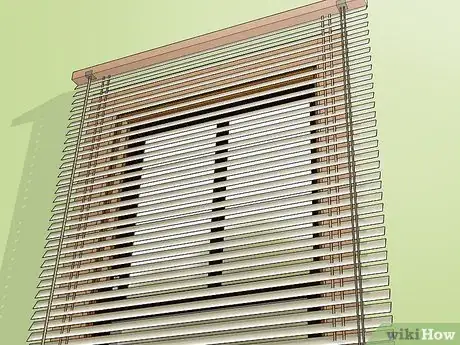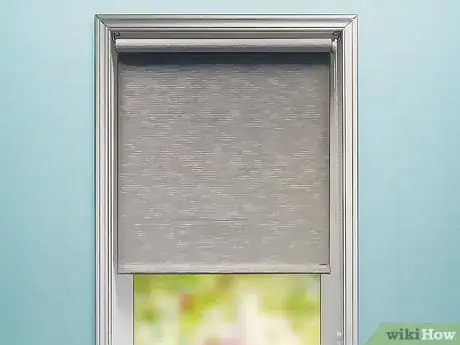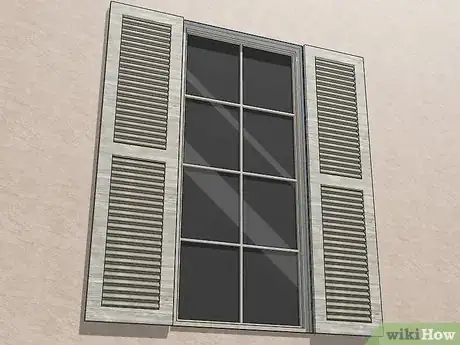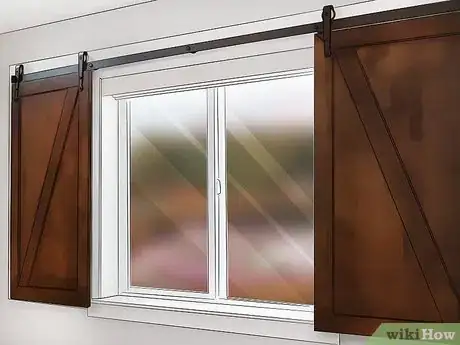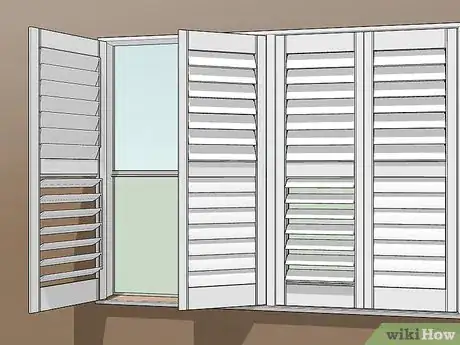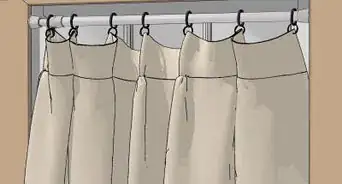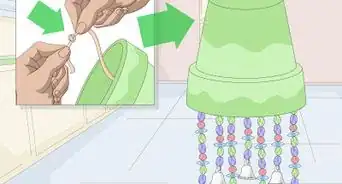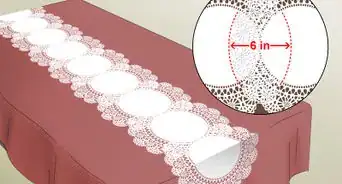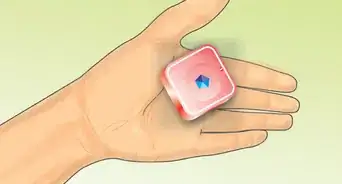This article was co-authored by Cindy Hofen and by wikiHow staff writer, Amy Bobinger. Cindy Hofen is a Certified Relocation Specialist and the founder of Managing Moves & More, a San Francisco Bay Area-based professional move management company specializing in start-to-finish moving solutions, home clearouts, estate sales, and home staging. Since 2009, her team has helped over 2,500 clients to simplify their transitions. Cindy has over 10 years of professional moving and organizing experience, is a member of the National Association of Senior Move Managers (NASMM), holds an A+ Accreditation, and belongs to the Diamond Society. She has a Master of Business Administration from Arizona State University and a BA in Business Economics from the University of California, Santa Barbara.
There are 12 references cited in this article, which can be found at the bottom of the page.
This article has been viewed 107,949 times.
Whether you just don't like the look of curtains or you aren't allowed to hang them, sometimes you need a creative way to cover your windows. Fortunately, the options are nearly endless. You can use household objects in front of the window to block the view, or you can create your own covering using film or glass paint. If you're looking for a more permanent option, you can hang blinds, shades, or shutters. Whatever you choose, your home is sure to look incredible once you add your personal touch!
Steps
Household Objects
-
1Place a sign or screen in front of the window for a temporary option. One of the fastest ways to cover your window is simply to prop something in front of it. You can use pretty much anything, from a sign or artwork to a privacy screen for larger windows. Just choose something that reflects your personal style![1]
- If your style is farmhouse-chic, prop up a pretty hand-painted sign with a cheery message like "There's no place like home."
- To cover a large bay window or sliding doors, try using a folding room divider that matches the rest of your decor.
- Propping something in front of the window is a great option if you want to be able to easily change the look of the window. In addition, you don't have to worry about putting any holes in the wall if you're renting.
-
2Put colorful glass bottles in the windowsill for a pretty display. A collection of glass bottles will catch the light beautifully. It will also help provide some privacy since anyone looking in will see the colorful glass, rather than the inside of your home. Search secondhand shops for cool glass pieces in a variety of shapes and sizes, or repurpose bottles you might already have on hand.[2]
- For a sleek look, stick to 1 or 2 colors for the bottles in your window. If your style is more eclectic, pick an array of bright shades.
- If you can't find any colorful bottles, try painting some yourself!
Advertisement -
3Mount a shelf in front of a window for partial coverage. A shelf is a great way to partially cover a window without blocking out natural light. Measure the width of your window, and buy a shelf that’s about 4 inches (10 cm) wider at a local home-improvement store. Mount the shelf as directed in the instructions—typically, you'll need to drill holes and screw in the brackets, and the shelf will sit on those brackets. Then, you can decorate the shelf however you'd like.[3]
- For instance, you might fill the shelf with a houseplant, a couple of books, and a decorative vase.
- Try using glass shelves to make the most of the natural lighting.
- As an added bonus, you'll get a little extra storage space!
-
4Hang a DIY valence made of draped fabric in front of the window. Drive 2 nails or push pins into the wall, 1 on either side of the top of your window. Tie a piece of twine or string between the nails, then hang 15–20 pieces of fabric over it. Each strip should be between 20–25 inches (51–64 cm) long. Use bandanas, scarves, or a leftover fabric garland.[4]
- The valence will fully cover the top portion of your window but still allow some visibility and natural light.
- For a more refined-looking valence, hang a curtain rod over your window, and drape pieces of fabric over the rod.
-
5Place 3–5 tall potted plants in front of a window. While plants aren’t technically a window covering, they’re effective at partially blocking visibility while allowing in natural light. Try setting a few leafy houseplants on the windowsill of a kitchen window, for instance. Or, if you want to cover a tall, narrow window, like in a hall or entryway, set a single tall houseplant directly in front of it.[5]
- For a low-maintenance option, use artificial plants, birch or willow branches, or dried pampas grass.
Coverings
-
1Attach faux stained glass to your windows for a colorful look. If you’d like to cover your windows while adding a burst of color to your home, faux stained glass is the way to go. Purchase pre-made faux stained glass windows at a hobby or craft-supply store. Depending on the window’s location, either lean the faux stained glass up against it or attach the glass to the window frame with mirror hanging hardware.[6]
- If you're a homeowner—or if your landlord okays it—you can paint your own stained glass design on the window with stencils and glass paint.[7]
-
2Layer gallery glass over your windows to create an opaque surface. Gallery glass is a liquid that you can apply directly to your windows—just brush it on and let it dry. You can buy gallery glass in a huge variety of colors. It dries opaque but still lets in some natural light.[8]
- If you want your window to have a textured look, run a toothpick through the gallery glass before it dries.
- To create a border on your window, or to define shapes on the glass, trace the outline with liquid leading first. Then, brush on the gallery glass after the leading has dried.[9]
- Purchase gallery glass and liquid leading at a local art-supply store or hobby shop.
-
3Apply window insulation film to the windows to keep in warm air. Window insulation film adds an insulating layer over your windows and will trap warm air in your home during chilly winter months. To apply it, stick the adhesive side of the insulation film directly onto the surface of the window. Then, blow hot air onto the film using a hair dryer. After 3-5 minutes, the film will shrink and fully adhere to the window.[10]
- Many of these films are transparent, so be sure you choose a tinted film if you want the extra privacy.
- Purchase window insulation film at a local hardware store or any major home-improvement store. The package should clearly state how much glass the insulation film will cover.
-
4Etch the glass for a frosted look. Pick up some glass etching cream and an artist's paintbrush from your local craft store, along with a stencil, if you'd like to use one. Clean the glass thoroughly and let it dry, then brush the etching cream onto the window and let it sit according to the directions. Then, rinse away the cream with a sponge and clean water. When you're finished, the window will have an opaque, frosted look—so you'll have all the privacy you need, with no curtains required![11]
- Be sure to wear gloves, since the etching cream can irritate your skin.
- Keep in mind that this effect is permanent, so if you're renting, you may need to ask your landlord's permission to do this.
Blinds and Shades
-
1Install vinyl blinds for a clean, simple look. Blinds are a great substitute for curtains. If you'd like to try blinds, you'll first need to measure the width and height of your window. Then, purchase blinds at a local home-improvement store. Begin the installation by hanging the brackets at the top corners of each window. Then, hang the head rail and attach the valence over it once the rail is in place.
- Basic horizontal vinyl blinds are a great option if you're shopping on a budget. However, there are more sophisticated options if you want to spend a little more!
- Blinds are a great option to cover your windows when you still want plenty of natural light. Just open them in the morning, then close them at night for more privacy.[12]
- Wood blinds are perfect when you want a warm, rustic look. However, don't install wooden blinds in the kitchen or bathroom, since the moisture could damage the wood.[13]
-
2Opt for vertical blinds in a window that’s wider than it is tall. Vertical blinds have a classy, chic look. They work especially well in tall, narrow hallway or entranceway windows that are less than 1 foot (30 cm) wide. They can't be raised or lowered, but you can still adjust the slats to let in more or less light depending on the time of day.[14]
- Installing traditional horizontal blinds in a tall, narrow window would be impractical and look odd.
-
3Use shades for a soft covering that allows ambient light. Choose shades if you need privacy but you still want some light throughout the day. Shades are typically made of soft cloth and can be raised or lowered anytime you want to adjust them. They also allow more ambient light than blinds and come in a larger variety of styles. Purchase shades at any home-improvement store.[15]
- Install honeycomb shades if you live in a cold climate. Honeycomb shades contain many small tubes of air that hold warm air to help keep your home warm overnight.
- Try woven wood shades in rooms that receive overly bright sunlight. Woven shades are typically made from bamboo. They block a great deal of light, but can still be raised and lowered depending on how bright the room needs to be.
-
4Select Roman shades in more formal dining or living rooms. Roman shades are made of billowy fabric, and they add a formal, classy touch to any room. You can raise or lower to let in more or less light, or to block the inside of your home from view at night. They’re considered a sleek option and are typically custom-ordered for individual windows. Also order blackout Roman shades if you’d like the option to shut out all light from a room.[16]
- If you like the idea of fabric shades but don’t have a formal room, choose a shade made of tightly woven opaque twill.
Shutters
-
1Mount panel shutters over your windows to block visibility at night. If you don't love curtains but you still need privacy, consider shutters. The horizontal slats allow partial visibility, but you can open or close them when you need to. They come in a variety of colors, sizes, and materials, so choose an option that suits the size of your windows. Typically, you'll mount the shutters directly onto the exterior of your home, although some can be installed indoors, depending on the look you're going for.[17]
- You can purchase shutters at any home improvement store.
- The shutters will come with directions for how to install them. However, if you’d rather not install the shutters yourself, the home-improvement store can send professionals to install them for you.
-
2Install interior barn door shutters for a rustic look. Indoor barn door shutters are practical, but they also have a gorgeous aesthetic. They give your home a rustic, rural appeal and, like traditional shutters, can be adjusted to let in more or less light throughout the day. Most styles of barn door shutters slide back and forth on track mounts.[18]
- Purchase barn door shutters at a home-improvement store near you. Many large online retailers and general home-supply stores also sell barn door shutters, although these may be a lower quality.
-
3Set up plantation shutters for full control over the visibility. Unlike panel shutters, plantation shutters can be adjusted from the inside of your home. All you have to do is raise or lower a bar that controls the shutter slats. This allows you to make slight adjustments to the amount of natural light that enters your home as the position of the sun changes. Plantation shutters also fully reduce visibility in at night.[19]
- Buy plantation shutters at any major home-improvement store.
References
- ↑ https://www.bobvila.com/slideshow/lose-the-drapes-15-better-ways-to-dress-a-window-50944
- ↑ https://www.hometalk.com/25432313/s-how-to-get-privacy-without-curtains
- ↑ https://www.brit.co/curtain-alternatives/
- ↑ https://www.brit.co/curtain-alternatives/
- ↑ https://www.hometalk.com/25432313/s-how-to-get-privacy-without-curtains
- ↑ https://abeautifulmess.com/2015/02/diy-faux-stained-glass.html
- ↑ https://www.bobvila.com/slideshow/lose-the-drapes-15-better-ways-to-dress-a-window-50944
- ↑ https://inmyownstyle.com/gallery-glass-ideas.html
- ↑ https://youtu.be/i_hp1dnaQoI?t=213
- ↑ https://www.apartmenttherapy.com/how-to-install-window-insulation-film-photo-tutorial-226572
- ↑ https://www.thisoldhouse.com/windows/21018267/everything-you-need-to-etch-glass
- ↑ Cindy Hofen. Professional Organizer & Home Staging Specialist. Expert Interview. 13 February 2020.
- ↑ https://www.goodhousekeeping.com/home-products/a18315/blinds-and-shades-shopping-tips/
- ↑ https://www.goodhousekeeping.com/home-products/a18315/blinds-and-shades-shopping-tips/
- ↑ https://www.goodhousekeeping.com/home-products/a18315/blinds-and-shades-shopping-tips/
- ↑ https://www.goodhousekeeping.com/home-products/a18315/blinds-and-shades-shopping-tips/
- ↑ https://www.pellabranch.com/blog/global-blogs/5-ways-to-beautify-your-windows-without-curtains-or-blinds/
- ↑ https://www.brit.co/curtain-alternatives/
- ↑ https://justagirlandherblog.com/how-to-measure-for-and-install-plantation-shutters/
About This Article
If you’re not a fan of curtains, there are plenty of other ways you can cover your windows. Install blinds on your windows for a clean look that’s fully adjustable to the amount of light and privacy you want. For a cheaper option, get fabric shades, which allow more ambient light than blinds when they’re closed. You can also install shutters, which give you partial visibility and a more rustic look compared to blinds. For a quick, temporary solution, hammer 2 nails into the wall above each corner of the window, tie string between the nails, and hang a sheet of fabric over the window. Alternatively, block the window with houseplants or other large objects for privacy. For more tips from our Interior Design co-author, including how to make your windows opaque, read on!









